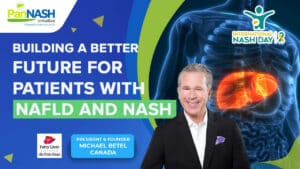Multistakeholder Approach to Innovations in NAFLD Care
INTRODUCTION ABOUT DR. JÖRN SCHATTENBERG
In this NAFLD webinar, Dr Jörn Schattenberg, director of the metabolic liver research program at the University Medical Center in Mainz, Germany, emphasized the need for multistakeholder approaches in non-alcoholic fatty liver disease, NAFLD care.
OVERVIEW OF THE MULTISTAKEHOLDER APPROACH TO INNOVATIONS IN NAFLD CARE
Table of Contents
Introduction
With the increasing prevalence of obesity and type 2 diabetes, hepatic complications related to non-alcoholic steatohepatitis (NASH) are expected to rise significantly, highlighting the urgency for innovative improvements to NAFLD care.
The most common chronic liver disease (around 33% of adults worldwide) Copyright ©2023 by PanNash™ Initiative – All rights reserved.
The Complexity of NAFLD and Its Comorbidities
NAFLD, a multisystem chronic liver disease, is a complex disease continuum that encompasses various stages, from early disease with fat accumulation, inflammation, and mild fibrosis to advanced cirrhotic stages (F3 and F4), which can lead to decompensation and hepatocellular carcinoma.
Patients with advanced NAFLD often possess comorbidities such as obesity, type 2 diabetes, cardiovascular disease, and arterial hypertension.
In fact, about 75% of individuals with type 2 diabetes have NAFLD, and among them, 10 to 15% already present with cirrhosis in a compensated stage.
The Fatal Triple with NASH Copyright ©2023 by PanNash™ Initiative – All rights reserved.
The challenge of caring for these patients implies that multiple stakeholders must collaborate to provide the best possible care. Studies in Germany have shown that NAFLD patients have a significantly higher incidence of cardiovascular disease over time, highlighting the need for a comprehensive approach to disease management and controlling fatty liver disease.
The Fatal Triple with NASH Copyright ©2023 by PanNash™ Initiative – All rights reserved.
Identifying and Managing NAFLD Patients
As an asymptomatic disease, raising awareness and educating patients and healthcare professionals is crucial for the early detection of NAFLD. Personalized approaches and clear clinical referral pathways are essential for providing best-practice care.
Public Health Measures to address NAFLD ©2023 by PanNash™ Initiative – All rights reserved.
For instance, healthcare providers should start screening type 2 diabetes patients for advanced liver disease and monitor their A1C levels to optimize glycemic control.
Dr Schattenberg outlined seven key questions for healthcare providers and policymakers:
- Who provides the care today?
- When and how often are these patients seen?
- What care must be provided, and how do we have to consider the disease stage in this context?
- In which healthcare setting is the care provided (primary or secondary care)?
- How can we bridge the gap to provide care when there is no access to a hepatologist?
- To what extent is care coordinated across healthcare systems?
- How can we optimize the gaps in care for NAFLD patients?
Public Health Measures to address NAFLD ©2023 by PanNash™ Initiative – All rights reserved.
Strategies for Innovations in NAFLD Care
Both bottom-up and top-down strategies can be employed to improve NAFLD care. Bottom-up approaches involve working with primary care physicians to develop efficient models of care, while top-down strategies require guidance from national and global entities to inform physicians about the necessary steps to be taken.
NAFLD in different settings ©2023 by PanNash™ Initiative – All rights reserved.
Currently, lifestyle intervention is the primary management strategy for NAFLD patients. However, there is a growing focus on drug development for holistic treatment approaches targeting metabolic diseases, such as obesity.
In the future, selecting the appropriate drug for patients with type 2 diabetes and advanced liver disease, particularly cirrhotic stages, will be crucial for providing optimal care.
NAFLD in different settings ©2023 by PanNash™ Initiative – All rights reserved.
Key Insights and The Path Forward in NAFLD Care
Both American and European guidelines recommend multistep approaches for identifying NAFLD patients using non-invasive tests. Weight loss remains the cornerstone of treatment today, but evidence for medical treatments is emerging.
Key Insight in NAFLD Care ©2023 by PanNash™ Initiative – All rights reserved.
Dr Schattenberg invited healthcare professionals to attend the Innovations in NAFLD Care’ meeting in Barcelona at the end of May 2023 to discuss and develop new models of NAFLD care.
Policymakers must recognize NAFLD as a chronic condition that burdens patients’ lives and increases healthcare costs, paving the way for a more comprehensive and coordinated approach to NAFLD care.








